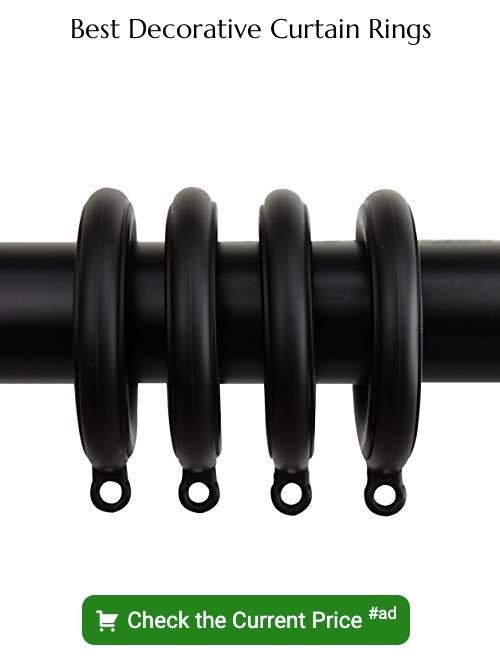This post provides a straightforward guide to hanging curtains with rings for an easy and elegant window treatment.
Hanging curtains with rings may seem daunting, but it’s actually a straightforward process. This article will guide you through each step, from gathering your materials to attaching the rings and hanging the curtains. Whether you’re a DIY novice or a seasoned pro, these tips will ensure your curtains hang beautifully and function perfectly.
Read on for a detailed, step-by-step guide that covers everything you need to know.
Key takeaways:
- Understand different types of curtain rod rings: eyelet, flat, bypass, clip-on, and D-rings.
- Choose curtain rings with clips that complement the weight and style of your curtains.
- Identify the right type of drapery rings for your curtains: standard, pleater, passing, sew-on, and C-rings.
- Determine the correct size of curtain rod rings based on your rod diameter, curtain weight, and aesthetic preference.
- Explore different curtain drapery ring styles: metal, wooden, plastic, clip-on, cafe style, pleater hooks, and S-rings.
- Follow the step-by-step guide to hang curtains with hooks and rings for an elegant window treatment.
- Attach curtain rings effectively by evenly spacing them along the top edge of your curtains.
- Calculate the number of rings needed based on your curtain rod’s length, weight, and desired spacing.
- Consider factors like material, size, weight load, design, ease of use, and durability when purchasing rings for your curtain rods.
- Fit curtains onto rings and hang them correctly by attaching the rings to the top hem of the curtains and sliding them onto the rod.
- Train your curtains for optimal appearance by pulling them to the width of the window and using steam to remove wrinkles and creases.
- Hang grommet curtains with rings by using rings that open and close or by sliding the grommets directly over the rod.
Understanding Different Types of Curtain Rod Rings
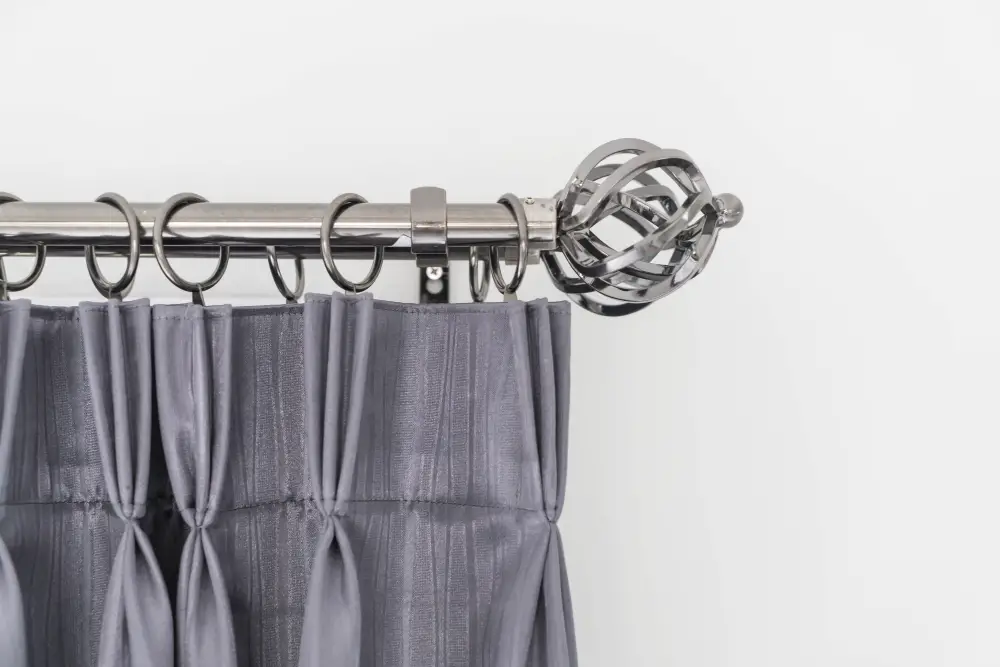
When it comes to curtain rod rings, it’s crucial to grasp the distinct kinds available to you, each with its function and aesthetic.
First, there are eyelet rings, often used for lightweight, thin fabrics and boasting an easy-slide feature for curtain movement. Then, we have flat rings which give a more streamlined appearance and stay hidden behind the scenes.
Slightly different are bypass rings, lauded for their ability to move undeterred along a track, bypassing supporting brackets. This makes them a viable choice for window corners or for curtains with a wrap-around feature.
Clip-on rings, known to be versatile and sturdy, come with little clips that can be attached to curtains without any hooks, making them an easy practical pick.
Lastly, D-rings get their name from the ‘D’ shape and are popular for hanging smaller signage or light swags rather than full curtain panels.
Knowing your options aids you in selecting the right rings for your window treatments. It’s key to match the type of ring to the weight and style of the curtain involved as well as the functionality you require.
Choosing Curtain Rings With Clips
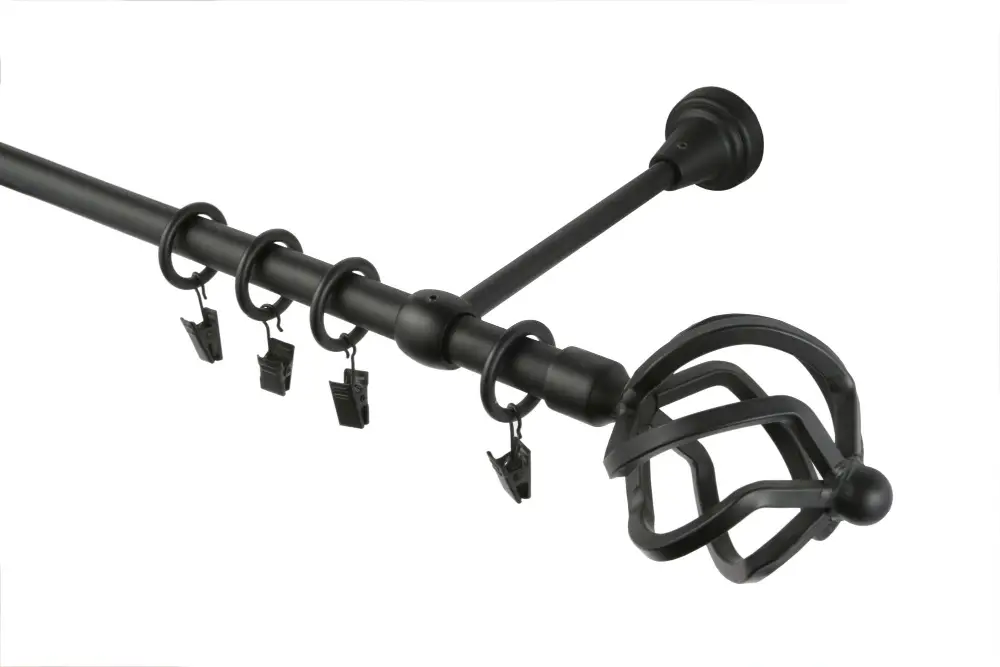
Curtain rings with clips have certain distinct advantages. Most notably, they allow easy attachment and detachment of curtains, making it a breeze to change window treatments when desired. These are particularly ideal for lightweight curtains, as they provide enough grip without causing fabric damage.
When picking curtain rings with clips:
- Consider the weight of your curtains. Thicker curtains may require larger, sturdier rings, while lighter fabrics can be hung on smaller or delicate rings.
- Choose a design that complements your curtain rods and room decor. You’ll find options ranging from clean, contemporary designs to vintage and ornamental styles.
- Ensure the clip’s color complements the color of your curtains and rods. In most cases, opting for neutrals like silver, black, or bronze is a safe bet.
- Evaluate the clip mechanism. It should open and close smoothly without catching the fabric, and hold firmly once closed.
- Test the sliding ability of the ring on the rod. It should glide effortlessly to allow easy adjustment of curtains.
Remember, rings with clips might not be suitable for fabrics with a loose weave or delicate materials, as the clips can cause wear or damage.
Identifying Standard Drapery Rings
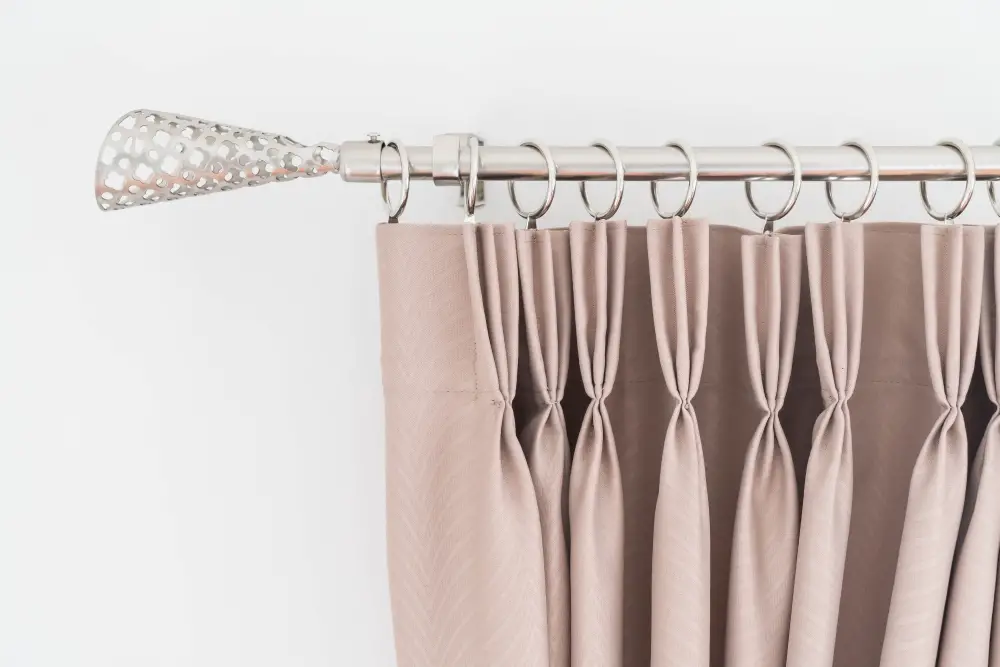
A standard drapery ring is a circular fixture, usually made from metal or plastic, which helps connect the curtain to the rod. These rings vary not just in diameter, but also in terms of their retainment mechanism.
Most designs have small clips on the bottom that securely grasp the top edge of the curtain. These clips can typically be opened and closed, making it easy to attach or remove the curtain.
Some rings are “eyelet style”. Here, the ring is threaded through a hole in the top of the curtain. This can provide a clean, modern look, but may not be suitable for all fabric types – especially heavier curtains.
There are also “pleater rings”. These are specifically designed for use with pleated drapes. They’re slightly more complicated to attach as they require pleater hooks, but give a sophisticated look once installed.
Sew-On rings, as the name suggests, can be sewn directly onto the curtain. They offer a trendy, industrial feel and work best for heavier or lined curtains.
Finally, “passing rings” are used for long stretches of curtain pole where the brackets interrupt the smooth movement of standard rings. They allow the curtain to move seamlessly across the rod.
Each type serves a specific purpose and adds a unique aesthetic touch to your drapery. Choose the one that best fits your rooms’ decor and functional needs.
Spotlight On C-rings for Curtains
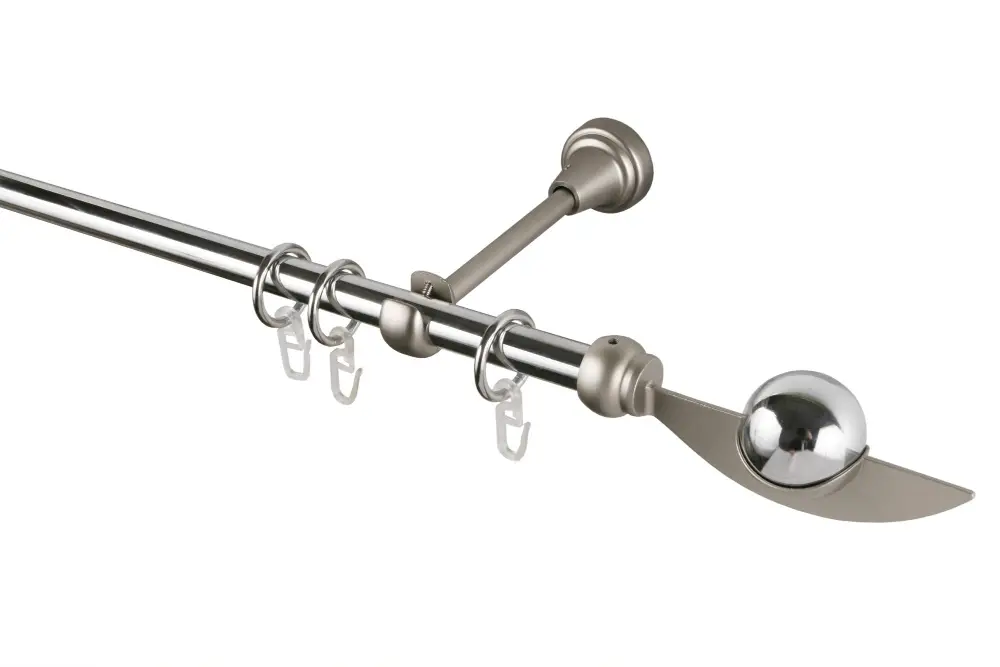
Often used in commercial or industrial settings, C-rings are notable for their distinctive design. These rings are open on one side and typically slide into a track on the curtain rod. This allows for seamless movement along the rod, which is particularly desirable for curtains that often need adjusting.
An appealing aspect of C-rings is their ability to be used with both light and heavy drapery materials. Their structure provides sturdy support for the curtains, reducing the chances of them sagging or becoming misshapen.
To set up, C-rings grip the top edge of the curtain panel determinately, and are not dependent on pin hooks. They are available in various diameters and styles, ensuring a suitable option for differing curtain sizes and aesthetics.
Practically, C-rings make removal and replacement of curtains from the rod easy, without requiring the rod to be taken down entirely. Their open design offers easier access for cleaning and maintenance, and they contribute to preserving the lifespan of your curtains by minimizing physical strain imposed on them.
Keep note, choosing the correct C-ring size ensures smooth sliding along the rod and helps maintain the overall visual appeal of your window treatment.
Determining the Correct Size of Curtain Rod Rings
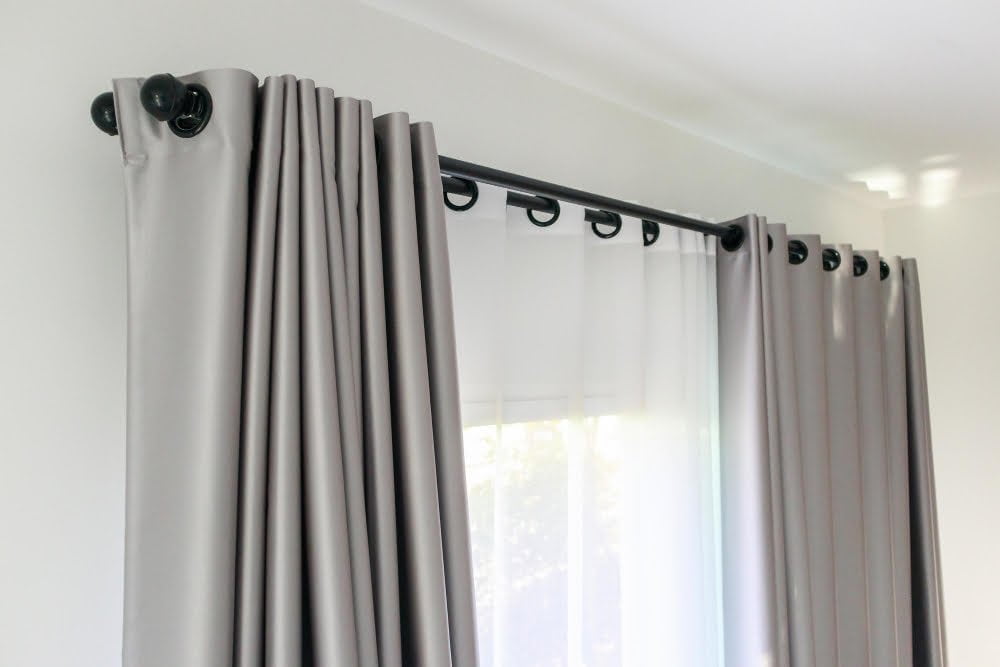
First and foremost, measure the diameter of your curtain rod. The inner diameter of your curtain ring must be larger than the rod’s diameter to slide smoothly.
Secondly, factor in the size of your curtains. Large, heavy curtains will require larger rings for support, while thin, lightweight materials can suffice with smaller rings.
Additionally, consider the aesthetic aspect. If you have a thick, decorative rod, larger rings can complement its look handsomely. On the other hand, a sleek, minimalist rod might look best with thinner, more discreet rings.
Lastly, remember that functionality should take precedence over aesthetics. No matter how good the rings look, if they’re not suitable for your particular curtain setup, they won’t serve their purpose.
Bear these factors in mind to ensure you procure curtain rod rings of the optimal size for your needs.
Exploring Different Curtain Drapery Ring Styles
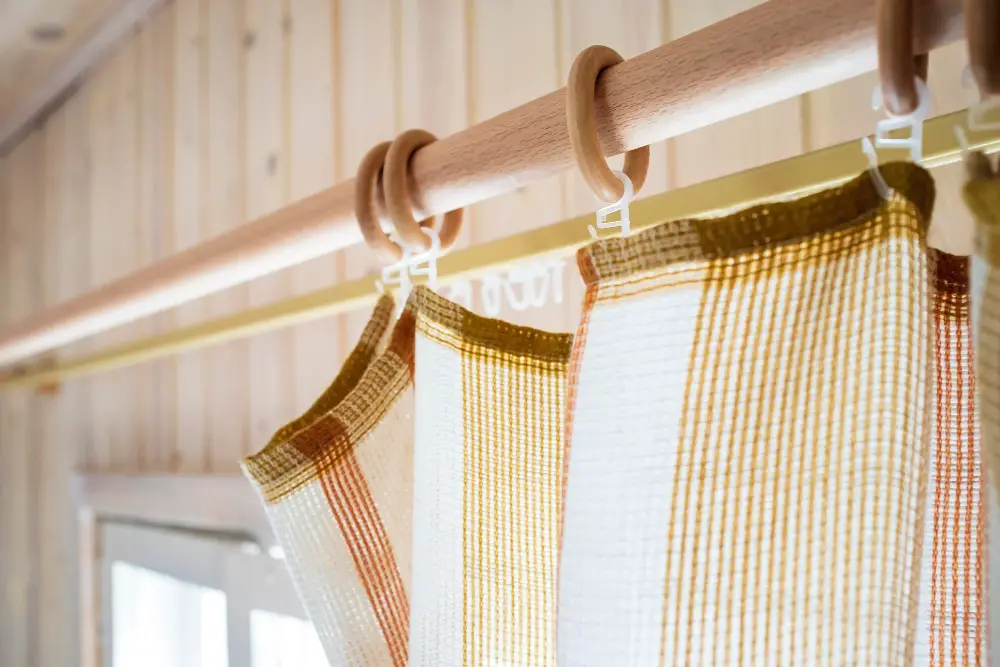
Within the diverse array of curtain drapery ring styles, each type provides a unique aesthetic appeal and functionality.
Metal curtain rings are characterized by their robust durability, often graced with decorative finishes such as bronze, silver or gold. They emit an industrial vibe that may accentuate modern or minimalist interiors.
Wooden curtain rings deliver a classic or rustic charm. They’re available in a wide range of colors and can be easily painted to match existing décor.
Plastic curtain rings propose a more economical choice, offering versatility in their shape, size, and color options. They’re lightweight, making them the perfect match for thin or fragile curtain fabrics.
Clip-on curtain rings feature small clips at the bottom, making a convenient solution for those who frequently change or wash their curtains. The ease of unclipping and reclipping the hooks add to its popularity.
Cafe style curtain rings have an eyelet large enough to fit over a rod, enabling smooth maneuvering of curtains. These rings exude quaint charm, making them ideal for vintage or rustic settings.
Meanwhile, pleater hooks can be slipped into the pleats or gathers at the top of the drapery panel. They provide a tidy, uniformly gathered look and are popular in formal or traditional settings.
Lastly, S-rings, named for their unique shape, fit over the rod and allow the fabric to be directly sewn or pinned into them. They deliver a custom appearance, ideal for those looking to create a tailored look.
Overall, selecting the right curtain drapery ring style hinges on your curtain’s material, the theme of your interior, and your personal preference.
Step-by-Step Guide On How to Hang Curtains With Hooks and Rings
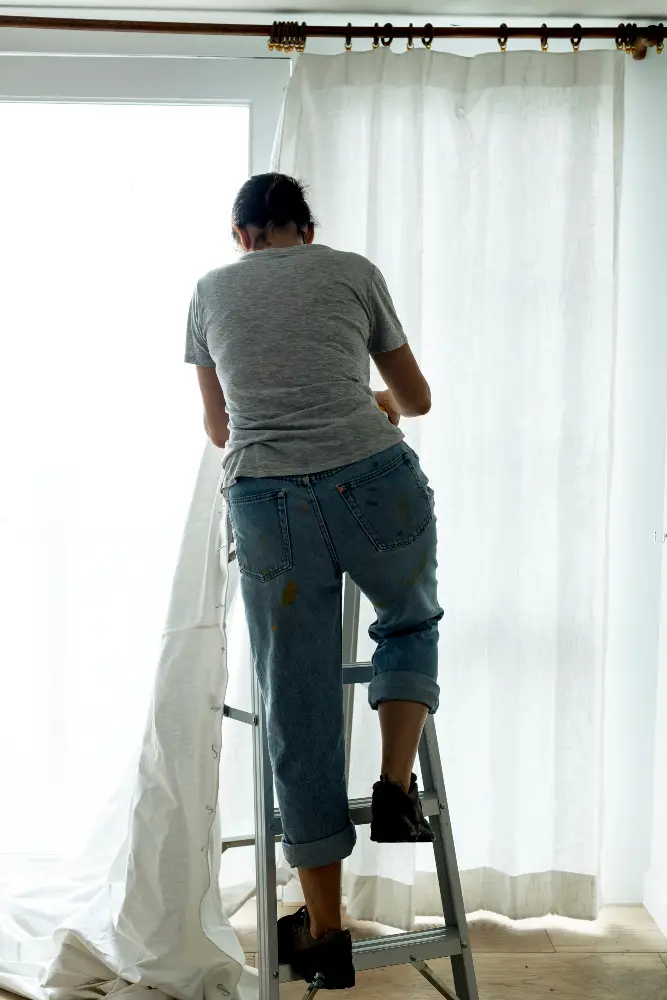
First, gather the necessary materials — the curtain, curtain rings with hooks, curtain rod, and a ladder if your windows are above your reach level.
Prepare the curtain by ironing or steaming to eliminate wrinkles. They should be clean and crisp before being hung.
Attach the curtain clips or hooks to the curtain. Start from one end and evenly space them at intervals down the length of your curtain. Most curtains need between 6-12 clips, depending on the curtain’s length and width.
Thread the curtain hooks or clips into the curtain rings. Ensure to distribute them evenly and keep a steady grip as some rings might have a spring-like mechanism that can snap back.
Secure the curtain rod onto its brackets. Once that’s done, slide the curtain rings featuring hooks onto the rod.
Consider the gap you want between the curtain top and the rod. Then, adjust the curtain’s height by moving the hooks higher or lower on the curtain.
Lastly, ensure the curtain rings are sliding smoothly on the rod and evenly distribute the curtain fabric. Try opening and closing the curtains a few times to ensure they’re hanging correctly.
That’s it! Now your curtains are up, ready to enhance the look and feel of your room.
How to Attach Curtain Rings Effectively
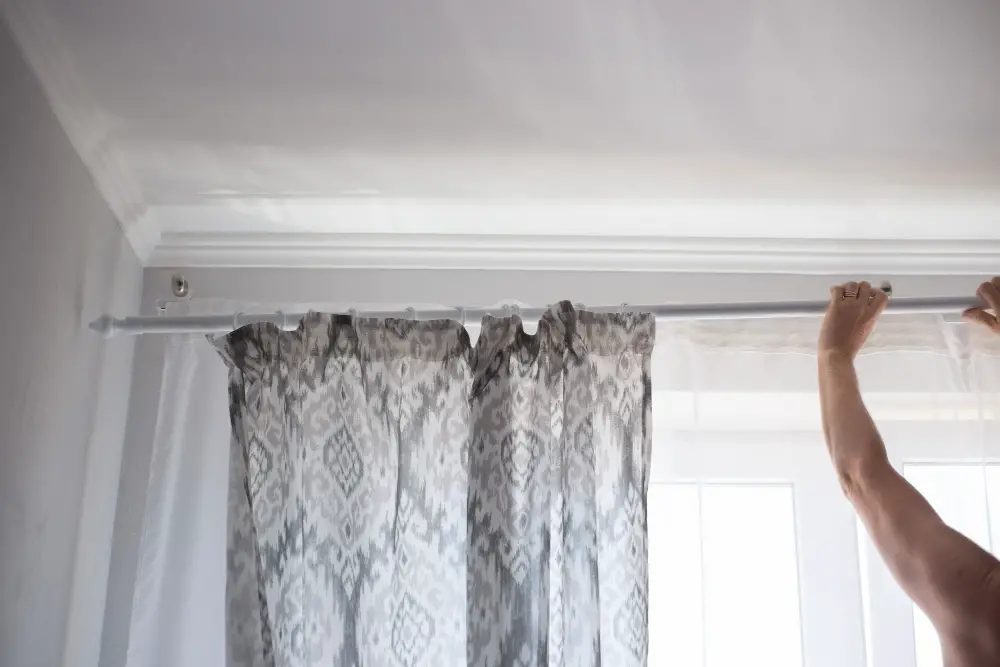
Gathering the necessary materials is the first step. These include your curtain panels, drapery rings with clips or hooks, and measure tape.
Start by spreading your curtain panel on a clean, flat surface. This ensures that the correct placement of rings and avoids unnecessary wrinkles.
To space the curtain rings evenly, begin by attaching the first ring to the extreme left of the curtain top. Following this, attach the second ring on the extreme right top of the curtain.
Measure the length between the first two rings and divide the distance by the number of unused rings plus one. This measurement is the spacing you will have between each ring for a balanced, even gathering of the material.
For each division point, attach a curtain ring. Make sure to keep your measuring tape handy and be consistent with the spacing.
Canvass the curtain length before attaching the clip or hook of the ring, make sure the ring is high enough so that the curtain hangs at the desired length. It also allows you to change the length of the draping for styling purposes.
Sliding the rings onto the curtain rod is the finale. Once they’re on the rod, evenly distribute them before placing the rod on its brackets.
Remember, don’t force the rings onto the rod. If they’re not fitting, it means the rod’s diameter is too large for these rings. Always check the compatibility of your curtain rod and rings before buying.
Finally, attach your curtain panel onto the rings, adjusting as necessary to achieve the look you want.
A tip to consider- you may want to turn the clips or hooks towards the window, this ensures they are not seen from the room side and gives your curtains a cleaner finish.
This process may feel time-consuming, but the attention to detail ensures a professional-looking finish to your window treatment.
Calculating How Many Rings For Drapes Do You Need
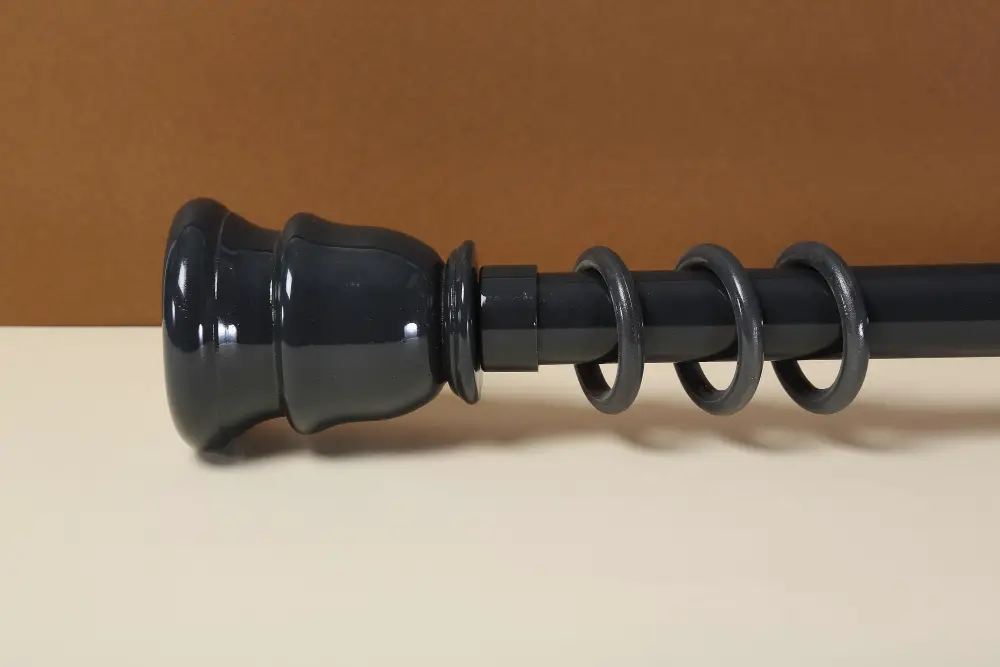
It often begins with your curtain rod’s length. As a rule of thumb, one ring should be designated for every foot of rod, with an additional ring located on each end of the rod for support. For instance, if the rod measures six-feet long, eight curtain rings would be needed – six for the body and one at each end.
Consider also the weight and style of your drapes. Heavier or pleated curtains may require rings spaced closer together for additional support and even distribution, whereas lightweight or sheer drapes can accommodate more spacing.
Remember to allow space for overlap when curtains are closed to ensure full coverage and privacy. This typically requires an additional two rings.
Lastly, consider the visual appeal – too few rings may result in a sagging look, while too many could appear crowded.
For precision, lay your curtain flat and measure its width, then divide by the desired spacing for the rings. A typical recommendation is to place rings every 4-8 inches, depending on the curtain style and weight. Decimal results should be rounded up to the nearest whole number. This method ensures an accurate ring count and respectful consideration of fabric type and window size.
Purchasing Rings for Curtain Rods: What to Look for
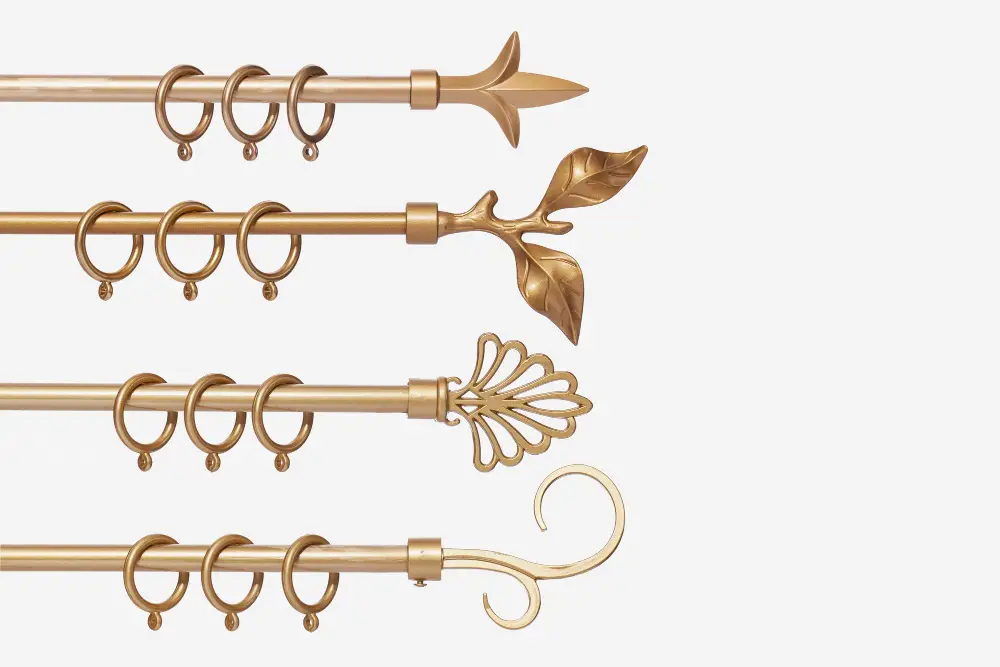
When buying rings for your curtain rods, consider these factors:
Material and Finish – curtain rings come in a variety of materials like metal, wood, or plastic. Opt for ones that match your rods and compliment your existing décor. The finish can be polished, brushed, or even ornately decorated.
Size – Curtain rings need to fit securely around the curtain rod. Measure the diameter of your rod to ensure compatibility.
Weight Load – The weight of the curtains will impact the type of rings needed. Heavy drapes require sturdy, well-built rings. Lightweight curtains can use smaller and simpler rings.
Design – While simple rings with clips can be virtually invisible, more ornate designs can add a decorative element.
Ease of use – Rings should slide effortlessly over the rod and the clips should be easy to open and close.
Durability – Given that they’ll be used frequently, your chosen rings should be sturdy and long-lasting.
Do a spot check – If possible, run a ring down a test rod in the store. This will inform you of any potential issues with sliding or fit before purchasing.
Remember, your curtain rings are not simply utilitarian. They can be stylish and contribute significantly to the overall look of your window treatments.
How to Fit Curtains Onto Rings and Hang Them Correctly
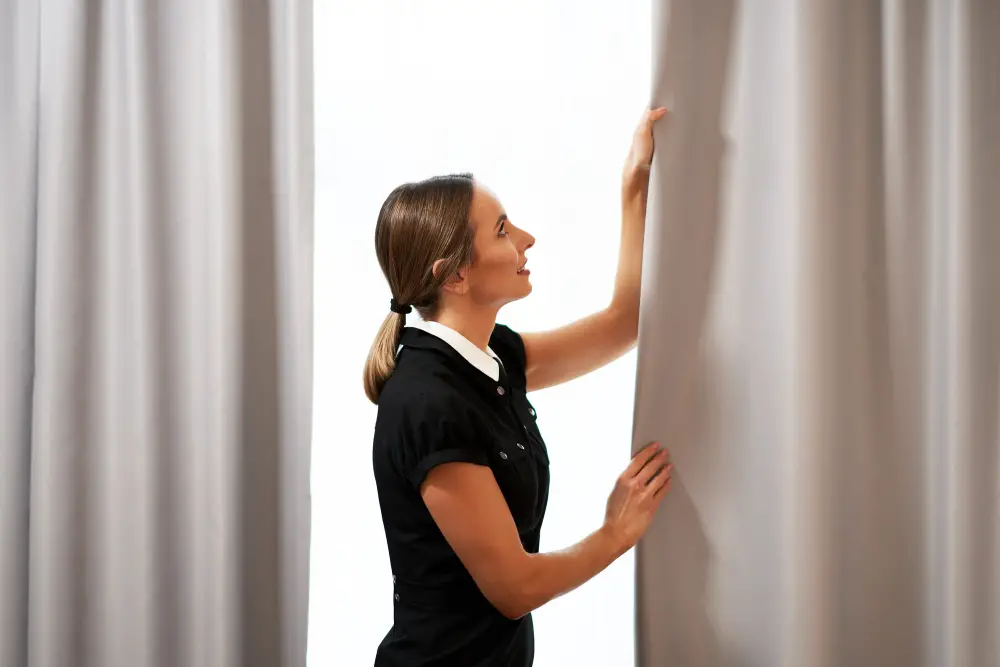
Begin with laying the curtain face down on a flat, clean surface. Spread it out so the top edge where the grommets or holes are is accessible.
Take your ring clips or drapery hooks, ensure they are open, and fix them to the top hem of your curtain. If your curtains come with sewn-in loops on the back, insert the hooks into these. Alternatively, if you’re using ring clips, clip them onto the top edge of the fabric, at equal distances apart. Aim to attach one ring around every 4-6 inches to maintain an even spread.
Ensure your curtain rod is securely mounted. For curtain rods with an end bracket, thread the rings onto the rod before attaching it back on the bracket. Leave one end of the curtain rod hanging on the bracket while you’re threading the rings onto the rod.
Place the curtain rings onto the curtain rod, ensuring an even spread. Slide each ring onto the rod, maintaining the same order you attached them to the curtain.
After all the rings are threaded, reconnect the loose end of the curtain rod to its bracket. Make sure the rod is secure before letting go.
At this point, the curtains should be hanging correctly from the rings on the rod.
Remember to adjust your curtains gently to make sure they are evenly spaced and drape well. Consider using a level or laser level to ensure the curtains hang straight.
For heavy curtains, ensure the curtain rod, brackets, and rings are fully capable of supporting the weight.
Regular dusting and cleaning of your curtain will also help maintain its elegant look.
Tips for Training Your Curtains for Optimal Appearance
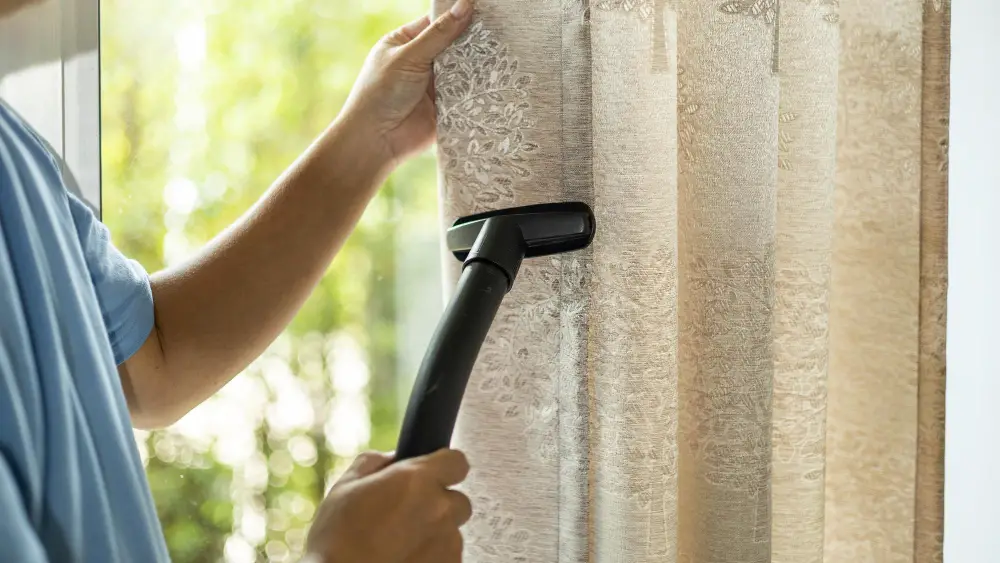
Training your curtains allows them to hang nicely and optimally on your windows.
Start by pulling your curtains into the width of the window and tie them loosely with soft fabric strips. Ensure that the curtains’ edges align with the edges of the window.
Keep this arrangement for at least one week, allowing the curtains to form subtle folds and a uniform draping pattern.
Use steam to remove any wrinkles and creases on the curtains. Do this while they are still tied and hanging on the window.
Remember to untie the curtains gently at night and re-tie them again in the morning during the first week of training.
Avoid ironing the curtains, as this could flatten the soft folds and ruin the final look.
Whenever you wash your curtains, you’ll need to repeat this training process to maintain that optimal appearance.
Using these tips, curtains can add elegance and visual interest to any room, enhancing your window and the overall decor in no time.
FAQ
Can you hang grommet curtains with rings?
Yes, you can hang grommet curtains with rings, either by using rings that open and close to slip through the grommets, or by sliding the grommets directly over the rod.
What tools and hardware are required to hang curtains with rings?
To hang curtains with rings, you’ll need a tape measure, a drill, wall anchors, screws, a rod, and the curtain rings.
Are there specific types of curtains that are best suited for ring attachments?
Pleated drapes, sheers, light cotton, and linen curtains are best suited for ring attachments due to their lightweight nature and ability to seamlessly slide along a rod.
How to ensure the correct placement and spacing of rings on curtains?
To ensure the correct placement and spacing of rings on curtains, measure the width of the curtain rod, divide this measurement by the number of rings you plan to use, and place each ring at the resulting intervals along the rod.
Recap
